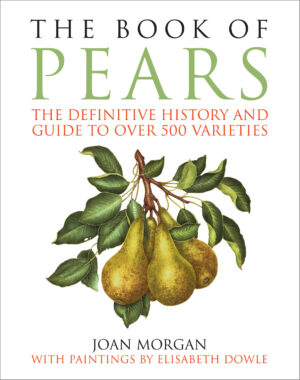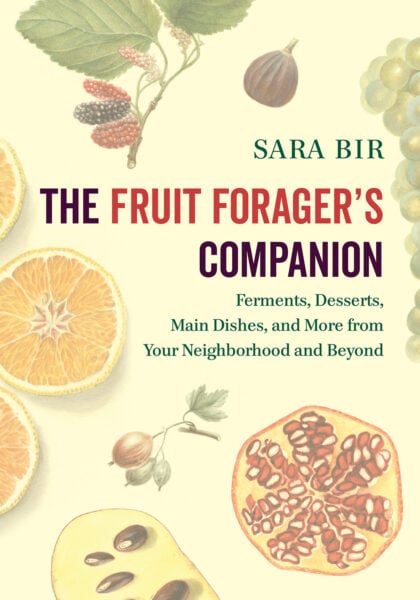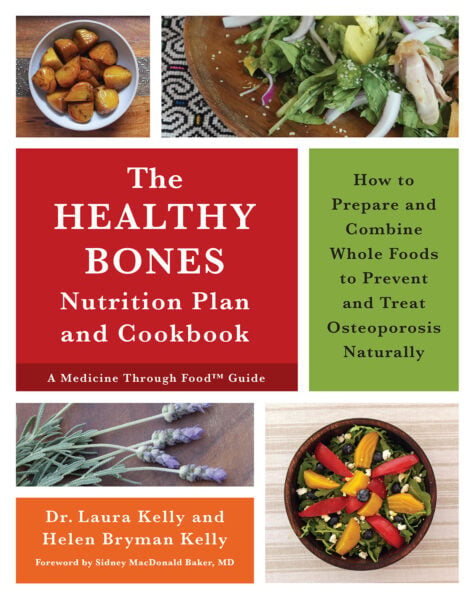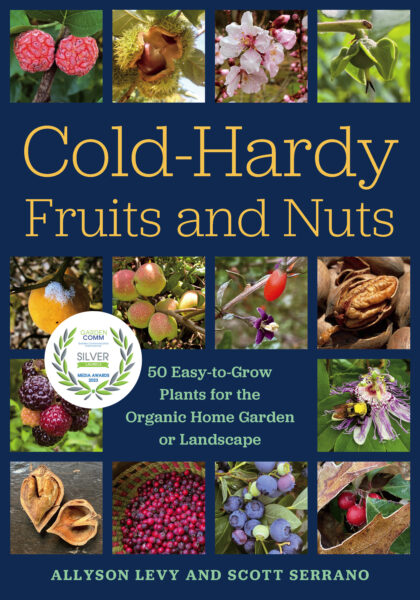Cooking With Pears: Tips & Recipes
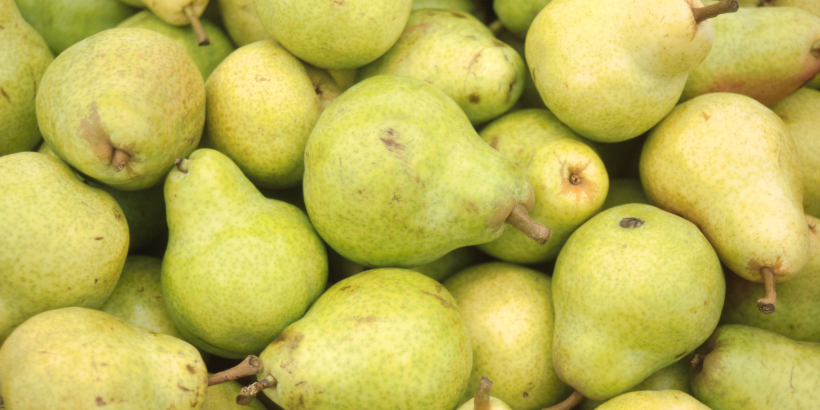
Now is the ‘pear-fect’ time to begin cooking with pears! Get started with help from these preparation tips — plus a few simple and delicious recipes.
The following is an excerpt from The Book of Pears by Joan Morgan. It has been adapted for the web.
A Guide to Cooking With Pears
The pear is mainly a fruit to eat fresh, with a sweet delicate taste, and as a cooked fruit is best treated very simply (in my experience). This is especially the case these days, since it will usually be dessert pears (fresh eating-quality pears) that are used rather than old-fashioned firm baking pears.
The favour of finely textured pears is easily overwhelmed by too much sugar or the addition of spices. On the other hand, such pears marry well with vanilla and almond favourings, and chocolate and butter make good partners.
Simple Ways to Enjoy Pears
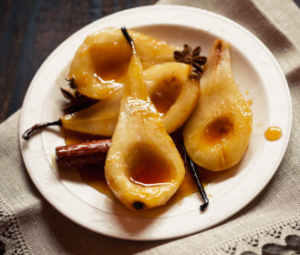 The simplest and possibly the nicest way to cook pears is to poach them – simmered gently in a light syrup and favoured with vanilla. These can then be presented as a bowl of fruit with cream or as individual pears in the style of the classic Poire Belle Hélène with ice cream and chocolate sauce.
The simplest and possibly the nicest way to cook pears is to poach them – simmered gently in a light syrup and favoured with vanilla. These can then be presented as a bowl of fruit with cream or as individual pears in the style of the classic Poire Belle Hélène with ice cream and chocolate sauce.
Another simple way to enjoy pears is to cook them briefy in a little butter, then add a dash of Marsala wine and a couple of spoonfuls of cream. There are of course many, much more elaborate, pear dishes, such as Pear Tatin or fruit tart, in which the pear halves are laid over a base of frangipane or crême patissière.
A more modest approach is to wrap pears individually in a strip of pastry, spiralling it around the fruit, then simply bake it. Whatever recipe you may be using (some are given opposite), the following points may be useful.
Cooking With Pears: Points and Tips
When using eating pears of the most widely available market varieties, such as Conference in the UK, it is best that the fruit is just about ripe, but not overripe. Unripe pears are immature with little favour, and although cooking may soften the texture, it cannot improve the taste.
After peeling pears, rub them all over with the cut surface of a lemon to prevent the fesh from discolouring. If the pears are to be served whole, core them from the eye end as they look best with the stalks intact. When using the fruit halved or sliced, remove the core and stalk. Ripe, eating pears need very little cooking – simply poach in a light syrup or fry them in butter.
Types of Baking Pears
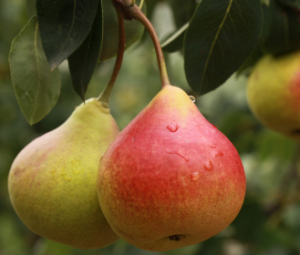 The old types of baking pear, such as Catillac and Black Worcester – perhaps the best known now – were said to require hours of cooking, but they seem to soften relatively quickly when poached. One route to catch their true flavour is to stew them and let most of the liquid be reabsorbed into the flesh.
The old types of baking pear, such as Catillac and Black Worcester – perhaps the best known now – were said to require hours of cooking, but they seem to soften relatively quickly when poached. One route to catch their true flavour is to stew them and let most of the liquid be reabsorbed into the flesh.
This is probably what happened in the past, when the pears were left at the side of the fre to cook very gently, or put in a ‘slack’ (low) oven and almost forgotten about until the time came to eat them. Then they became a ‘sweetmeat’.
You can add some sugar or cook them in wine, but some of the old baking pears will become quite sweet simply stewed in water alone, which turns the flesh of many of them a pretty red colour.
The Directory entries for each one of the baking pears include the results of my own tests (simply cooked in water) and provide an idea of their cooked taste. Double de Guerre, for instance, which remains quite well known in its native Belgium, is richly flavoured when cooked and can turn a deep red. Similarly, Suffolk’s Winter Orange becomes sweet and attractive, and Bellissime d’Hiver, formerly widely planted in country house gardens, is full of flavour when stewed.
Baking Pear Characteristics
Like most baking pears, they retain, at least early in their season, a hint of astringency, which gives extra interest and a pleasing taste, although they may need cooking very slowly for a long time to develop a good deep colour. Most baking pears are not picked until October and will keep into the new year, with some lasting to February and March in amateur stores.
Just as happens with late-keeping cooking apples, flavours tend to fade as their season progresses, and while baking pears will remain frm and sound, they lose acidity and taste after keeping for several months. Although the fesh of baking pears softens with cooking, the fruit retains its shape and remains frmer than a cooked eating pear such as Conference.
Dual-Purpose Pears
A few pears are regarded as dual purpose. Vicar of Winkfeld – known as Curé on the Continent – though usually regarded as a culinary pear, can be pleasant when eaten fresh in a good year. When cooked, it is not coarsely textured like the old baking pears; it has a much finer texture.
Pitmaston Duchess, a widely planted and admired pear, can be quite sharp when eaten fresh, but is good in a cooked dish. A number of the small summer pears, which are juicy and tasty eaten fresh but quickly go over, were known to be preserved in a heavy syrup or turned into candied fruit.
Cooking With Pears: Recipes to Try
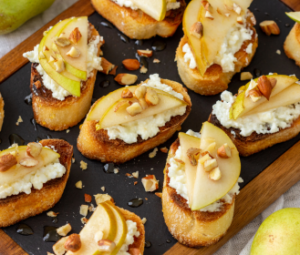 Pears can also be used in savoury dishes and salads: a sliced ripe pear with fresh chicory and a few walnuts is a lovely combination, dressed with oil and lemon juice. However, the best way to eat pears in a savoury context is with cheese.
Pears can also be used in savoury dishes and salads: a sliced ripe pear with fresh chicory and a few walnuts is a lovely combination, dressed with oil and lemon juice. However, the best way to eat pears in a savoury context is with cheese.
There is an old Italian saying: Al contadino non far sapere quanto e buono il formaggio con le pere (Do not let the peasant know how good cheese is with pears).
This could mean that an exquisite pear and fine cheese were beyond the reach of a mere peasant or, on the other hand, that the peasant knew already how good they were together, so it was wise to guard your best pears or the cream of the crop might disappear overnight.
A perfectly ripe choice pear, such as Doyenné du Comice, and a piece of Stilton cheese do indeed go very well together.
Poached Pears
Peel and core four medium to quite large pears (such as Conference) and rub them with lemon juice. Make a poaching liquid with 350ml (1⁄4 pint) water, 50g (2oz) sugar and a glass of white wine. Warm the liquid to dissolve the sugar, then bring to the boil.
Add a vanilla pod, then slide in the pears, whole or sliced, adding any dribbles of lemon juice. Let them simmer gently for 5–10 minutes. Lift them out and place in a serving dish. Reduce the poaching liquid to about half its volume and pour over the pears. Cool and serve with cream.
Poire Belle Hélène
Poach whole pears as above, standing them on their eye end with the stalk uppermost. It may be necessary to make the eye end into a fat base by cutting a thin slice off so that the pear will remain upright.
Serve with one or two scoops of homemade vanilla ice cream and pour over chocolate sauce. To make your own, melt some plain chocolate in a couple of tablespoons of hot coffee in a bowl set over a saucepan of simmering water.
Pears Tossed in Butter
Peel and core pears, remembering to rub them with lemon juice. One pear per person is probably suffcient. It is easy to make one serving at a time, and very quick to do in a small pan. Cut the pear into thick slices (about eighths).
Melt a small amount of butter (just a little knob) to coat the base of the pan, add a vanilla pod (if you wish), the sliced pear, an extra squeeze of lemon juice and a dusting of sugar (1 teaspoon or so). Gently heat the pears, moving them around in the butter until they show a little colour. A dash of Marsala (1 tablespoon) makes a nice addition, then spoon over about 2 or 3 tablespoons of cream. Allow it to warm, then serve.
Pears Wrapped in Pastry with Crème Anglaise
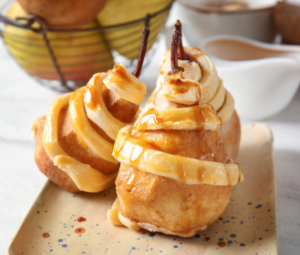 Peal and core the pears as before, leaving the stalk intact, and rub them with lemon juice. Use shortcrust or sweet shortcrust pastry made in the usual way. The following amount is plenty for four pears: 150g (5oz) plain four; 65g (21⁄2oz) butter; pinch of salt; a few tablespoons of milk; plus 50g (2oz) sugar if making sweet pastry.
Peal and core the pears as before, leaving the stalk intact, and rub them with lemon juice. Use shortcrust or sweet shortcrust pastry made in the usual way. The following amount is plenty for four pears: 150g (5oz) plain four; 65g (21⁄2oz) butter; pinch of salt; a few tablespoons of milk; plus 50g (2oz) sugar if making sweet pastry.
Roll the pastry out fairly thin and cut into long strips about 2.5cm (1 inch) wide; also cut out a small square of pastry for each pear, large enough to make a base.
Push a small curl of lemon peel and an extra squeeze of lemon juice into the centre of each pear. Cut a thin slice off the bottom of each pear so that it will stand on its base. Set a pear on the square of pastry and coil a strip of pastry around it (you might need more than one strip to enclose it completely).
Begin at the base and let the strip overlap a little as you wind it around the pear. Finish off at the top, moulding it around the bottom of the stalk. At the other end of the pear – the base – mould the pastry square to fit and neatly join with the coils.
Brush with milk, or egg and milk wash. Bake at 180°C/gas mark 4 for about 45 minutes, or until nicely browned. The result is a fragrant, melting pear, delicious served warm with cream or, better still, with crême anglaise – real custard.
Crême Anglaise
1 egg and 1 egg yolk beaten together with 75g (3oz) sugar in a bowl. Bring 300ml (1⁄2 pint) milk with a vanilla pod just to the boil, pour the hot milk over the eggs and sugar and stir until the sugar has dissolved. Return to the pan and cook gently until the custard is thick enough to coat the back of a spoon.
Pears in Red Wine
Baking pears are the best sort for this dish. Catillac or Black Worcester are ones that might be available as many trees still grow all over the UK. I have also used Martin Sec pears, which are small to medium-sized and keep sound until well into February.
When simmering the pears, use a pan in which they can all fit snugly. For 8–10 medium-sized pears, bring to the boil about 750ml (11⁄2 pints) of half water and half red wine with 75g (3oz) sugar and some sticks of cinnamon. Add the pears – peeled, cored and rubbed with lemon juice, and with the stalks left on – and let them cook very gently until they have softened.
The time will depend on the cooking temperature and whole pears may take 1–11⁄2 hours. The liquid will be reduced by then to about half its original volume. Let the pears cool in the liquid and serve as a dish of fruit with cream. Alternatively, let the liquid reduce some more until it becomes almost a glaze, but do not overcook the pears in the process.
Recommended Reads
How to Grow and Maintain Fruit Trees: General Fruit Tree Management
Recent Articles
Chances are, you’ve seen cattails growing on the edge of your local lake or stream at least once or twice. Instead of just passing these plants, try foraging for and cooking them to create delicious seasonal dishes! The following excerpt is from The New Wildcrafted Cuisine by Pascal Baudar. It has been adapted for the…
Read MoreGarlic mustard: while known as “invasive,” this plant can be consumed in its entirety and has great nutritional value. Plus, the garlic-flavor is a perfect addition to any recipe that calls for mustard! The following are excerpts from Beyond the War on Invasive Species by Tao Orion and The Wild Wisdom of Weeds by Katrina…
Read MoreOh, honeysuckle…how we love thee. If only there was a way to capture the sweet essence of this plant so we could enjoy it more than just in passing. Luckily, foraging and some preparation can help make that happen! Here’s a springtime recipe that tastes exactly like honeysuckle smells. The following excerpt is from Forage,…
Read MoreIntroducing…your new favorite brunch dish! This whole broccoli frittata is packed with fresh, wildcrafted flavors that are bound to help you start your day off on the right foot. The following is an excerpt from The Forager Chef’s Book of Flora by Alan Bergo. It has been adapted for the web. RECIPE: Whole Broccoli Frittata…
Read MoreWondering where to forage for greens this spring? Look no further than hedges, which serve as natural havens for wild greens and herbs! The following is an excerpt from Hedgelands by Christopher Hart. It has been adapted for the web. Food from Hedges: Salads and Greens Let’s start by looking at all the wild foods…
Read More

